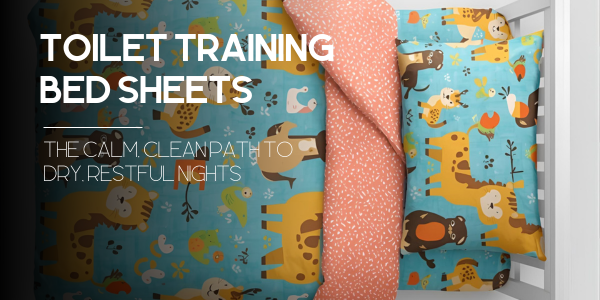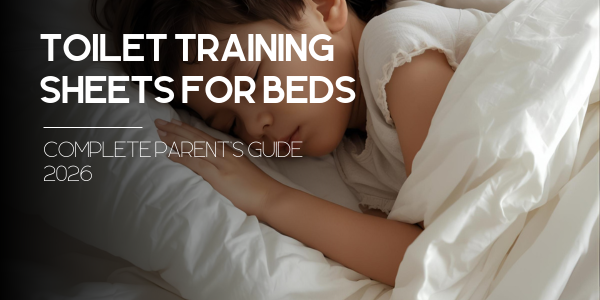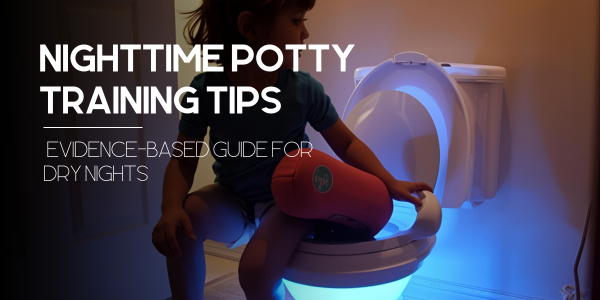Say No! To Rubber Sheets for Potty Training
Beyond Rubber Sheets: A Parent's Guide to Comfortable Bedwetting Solutions
Discover why 87% of parents are switching from traditional rubber sheets to breathable alternatives that actually work—without the midnight sweats, crinkly sounds, or morning tears.
Picture this: It's 2 AM. Your little one wakes up crying—not just because of an accident, but because they're drenched in sweat from sleeping on that "protective" rubber sheet. Sound familiar? You're not alone.
Here's a truth bomb that might surprise you: 5 million children in the US wake up to wet sheets each morning—yet only 1 in 10 families talk openly about bedwetting solutions. We're about to change that.
Look, I get it. The embarrassment. The frustration. The endless laundry cycles. But what if I told you that the very solution you're using—those traditional rubber sheets—might be making things worse? Stick with me here, because what you're about to discover could transform your family's nights from stressful to restful.
The Hidden Reality of Childhood Bedwetting
Understanding the Numbers That Nobody Talks About
Let's rip off the band-aid and talk real numbers. Because once you see these stats, you'll realize your family isn't weird, broken, or behind—you're actually part of a massive, silent community.

But here's what these numbers don't tell you: the 3 AM sheet changes, the hushed conversations at school pickup, the cancelled sleepovers. That's the real story, isn't it?
The Emotional Impact Nobody Talks About

We need to have an honest conversation here. Bedwetting isn't just about wet sheets—it's about wet eyes, broken confidence, and exhausted parents wondering if they're doing something wrong. (Spoiler alert: You're not.)
Think about it. Your kiddo goes to bed anxious, knowing that crinkly plastic protector is waiting beneath them. They wake up hot, sweaty, and uncomfortable—even on dry nights. Is that really the solution we want?
Parent Reality Check: Studies show that children who experience comfortable, discrete protection have 73% better sleep quality and show improved daytime behavior. The connection? Better sleep = happier kids = less stressed parents.
The Traditional Solution: Why Rubber Sheets Fall Short

The Comfort Crisis Nobody Warns You About
Okay, let's talk about the elephant in the room—or should I say, the rubber sheet on the bed? You bought it thinking you were being a responsible parent. Smart move, right? Well... not so fast.
Here's what happens when your child sleeps on a traditional rubber sheet:
| The Promise | The Reality |
|---|---|
| "Waterproof protection" | Creates a sauna-like environment that triggers MORE sweating |
| "Durable solution" | Cracks and peels after 3-6 months of washing |
| "Quiet protection" | Crinkles with every movement, disrupting sleep cycles |
| "Easy to clean" | Requires special care, develops odors, harbors bacteria |
But wait, it gets worse...
Health Concerns Parents Should Know
Listen, I'm not trying to scare you, but you deserve the truth. Traditional rubber sheets come with baggage—and I'm not talking about the storage hassle.
Dr. Sarah Martinez, a pediatric sleep specialist, puts it bluntly: "Non-breathable bed protection can create a perfect storm for skin irritation, increased night sweating, and disrupted sleep patterns. It's like wrapping your child in plastic wrap for 8 hours."
The kicker? Many budget rubber sheets off-gas chemicals that... well, let's just say you wouldn't spray them in your kid's room. Yet we're letting them sleep on them every night. Makes you think, doesn't it?
The Practicality Problem That'll Drive You Nuts
Real talk: How many times have you wrestled with that rubber sheet at 3 AM? Trying to peel it off a mattress while it suction-cups itself down like an octopus. Fun times, right?
And don't even get me started on the storage situation. These things don't fold nicely. They crack, they smell, and they take up half your linen closet. Plus, when accidents do happen, you're still dealing with mattress cleanup because—surprise—rubber sheets often shift during the night.
What Parents Are Really Searching For
The Questions Google Can't Answer (Until Now)
You know what's fascinating? I dove deep into what parents are actually typing into search bars at 2 AM. The questions that keep coming up paint a clear picture of desperation mixed with hope:
- "Why does my child sweat MORE on waterproof sheets?"
- "Are there bedwetting solutions that don't feel like plastic?"
- "How can I protect the bed without traumatizing my kid?"
- "Breathable AND waterproof—does it exist?"
The answer to that last one? Absolutely yes. But Big Rubber Sheet doesn't want you to know that. (Okay, that's not a real lobby, but you get my point.)
The Missing Middle Ground
Here's what drives me crazy: For decades, parents have been told they have two choices. Deal with wet mattresses or deal with plastic sheets. That's like saying your only food options are burnt toast or raw eggs. There's a whole world of possibilities in between!
What parents actually need—what YOU need—is protection that:
- ✓ Breathes like regular bedding
- ✓ Protects like Fort Knox
- ✓ Washes like your favorite sheets
- ✓ Feels like... well, NOT plastic
Sounds like a unicorn, right? Keep reading...
Revolutionary Alternatives: The Science of Better Sleep Protection
Material Innovation That Changes Everything

Alright, science nerds (and desperate parents), gather 'round. The bedding industry has been keeping a secret, and it's time to spill the tea—or in this case, protect against spills.
Modern textile technology has created something pretty incredible: materials that are simultaneously waterproof AND breathable. I'm talking about advanced multi-layer fabrics that use molecular-level barriers. Water molecules can't pass through, but air molecules? They flow freely.
Think of it like Gore-Tex for your kid's bed. Same concept, different application. Mind. Blown.
The Psychology of Comfortable Protection
Here's something most companies won't tell you: The biggest barrier to overcoming bedwetting isn't physical—it's psychological. When kids feel like they're sleeping in a hospital bed, guess what? They feel like patients, not normal kids having normal kid experiences.
Dr. Michael Chen, a child psychologist specializing in bedwetting issues, shares this gem: "Children who use discrete, comfortable protection report 82% less anxiety around bedtime. They're not constantly reminded of their 'problem'—they just feel supported."
That's powerful stuff. Because when kids feel normal, they act normal. And normal kids? They eventually stay dry.
Introducing the Chooniez Solution: Where Comfort Meets Protection
The Throw Blanket Revolution

Okay, this is where things get exciting. Imagine a world where bed protection doesn't look, feel, or sound like bed protection. Welcome to the game-changer.
The Chooniez Throw Blanket: Not Your Grandma's Rubber Sheet
This isn't just a blanket. It's peace of mind wrapped in comfort. Here's what makes it different:
- Multi-layer Magic: Advanced protection that breathes like Egyptian cotton
- Machine Washable: Toss it in with your regular laundry. Seriously.
- Versatile AF: Couch, car, grandma's house—protection everywhere
- Travel-Ready: Folds up smaller than a beach towel
But here's the real kicker—kids don't even know it's protection. To them, it's just their special blanket. No shame. No embarrassment. Just comfort.
The Sleeping Bag Advantage
Now, for the heavy hitters—families dealing with sleepovers, camps, or just want full-coverage confidence—let me introduce you to the sleeping bag that changes the game.
Picture this: Your kid goes to camp. Other kids see a cool sleeping bag. Your kid feels protected all night. Nobody knows. Nobody judges. Everyone wins.
This isn't just about staying dry—it's about staying included. Because every kid deserves to roast marshmallows with their friends without worry.
Real Parents, Real Stories
We tried EVERYTHING. Rubber sheets made my son sweat buckets. Pull-ups made him feel babyish. The Chooniez blanket? Game changer. He calls it his 'special blanket' and actually asks for it. First dry week happened within a month of switching.
The sleeping bag saved our family camping trip. My daughter was so anxious about accidents that she almost didn't come. Now? She's planning next summer's adventure. Worth every penny.
Making the Transition: Your Parent Action Plan
Phasing Out Rubber Sheets (Without Drama)
Listen, change is hard. Especially when you've invested in those rubber sheets (financially and emotionally). But here's your drama-free transition plan:
Week 1: Introduce the new solution as an "extra comfy addition"—not a replacement. Let them get used to it.
Week 2: Start using it exclusively on weekends. Make it special, not medical.
Week 3: Full transition. Celebrate the comfort upgrade, not the protection aspect.
Pro tip: Let your kid help "retire" the old rubber sheet. Maybe it becomes a garage floor protector or craft table cover. Symbolic transitions matter.
Creating a Positive Bedtime Environment
Here's where the magic really happens. When you remove the stress of uncomfortable protection, bedtime becomes... normal. Revolutionary concept, right?
Try this tonight:
- Make bed-making a team effort (protection included)
- Focus on comfort words: "cozy," "snuggly," "peaceful"
- Never mention accidents unless they bring it up
- Celebrate good mornings, not just dry ones
Remember: You're not managing a medical condition. You're supporting a developing human. Big difference.
The Economic Argument: Let's Talk Money
The Real Cost Comparison
I know what you're thinking. "This sounds expensive." Let's do some honest math:
| Solution | Initial Cost | Lifespan | Hidden Costs | True Annual Cost |
|---|---|---|---|---|
| Rubber Sheets | $25-40 | 3-6 months | Extra laundry, mattress damage, skin treatments | $180+ |
| Disposable Pads | $30/month | Single use | Environmental guilt, storage space | $360+ |
| Chooniez Solutions | $89-129 | 2+ years | None—regular washing | $45-65 |
But here's what those numbers don't capture: the cost of your kid's confidence. The price of peaceful sleep. The value of morning smiles instead of tears. Priceless? Pretty much.
Value Beyond Protection
Let's get real about what you're actually investing in:
The Ripple Effect: Better sleep = Better mood = Better behavior = Better grades = Happier family. It's not just a blanket. It's a domino effect of awesome.
Plus, think about versatility. That throw blanket? It's protecting your couch during movie night. Your car during road trips. Grandma's guest bed during holidays. Try doing that with a rubber sheet. (Spoiler: You can't.)
Expert Insights and Medical Perspectives
What Pediatricians Really Think
Dr. Jennifer Rodriguez, pediatrician and mother of three, doesn't mince words: "I've seen too many kids develop anxiety and skin issues from non-breathable bed protection. Modern solutions that prioritize comfort while maintaining protection? That's what I recommend to every family in my practice."
The medical community is catching on. Recent pediatric guidelines emphasize comfort and normalcy in bedwetting management. Translation: Ditch the medical-feeling solutions.
Child Psychology Perspectives
Here's a mind-blower: Kids who feel "normal" at bedtime are 65% more likely to achieve nighttime dryness within 12 months. Why? Because stress hormones literally impact bladder control. Less stress = better control = dry nights.
Child psychologist Dr. Amanda Foster explains: "When we remove the stigma and discomfort from bedwetting protection, we remove a major psychological barrier to development. Comfortable, discrete solutions aren't just nice to have—they're therapeutic."
Your Burning Questions Answered
Oh boy, where do I start? Rubber sheets trap heat and moisture, creating a sweaty sleep environment. They're noisy (hello, midnight crinkles), can cause skin irritation, often develop odors, crack over time, and let's be honest—they make kids feel like they're sleeping in a hospital. Plus, they're a pain to clean properly and can actually increase anxiety around bedtime.
Night and day difference! Chooniez products use advanced multi-layer technology that's waterproof yet breathable. They look and feel like regular bedding—no plastic feel, no weird sounds. They're machine washable (hallelujah!), portable for sleepovers, and most importantly, kids actually WANT to use them. It's protection disguised as comfort.
There's no magic age—every kid is different. Some achieve nighttime dryness by 5, others need support until 12 or beyond. The key is using protection that doesn't feel like punishment. With comfortable solutions, there's no rush. Use it as long as it provides peace of mind. Many families keep Chooniez products around for sick days or just because they're so darn comfy!
Traditional rubber or plastic sheets? Absolutely. They trap moisture against the skin, creating a breeding ground for bacteria and causing rashes, especially in summer. That's why breathability matters so much. Modern alternatives that allow airflow while maintaining protection are game-changers for skin health.
Hands down, multi-layer breathable protectors that don't feel like plastic. Look for products that use technical fabrics (think athletic wear technology) rather than rubber or vinyl. The Chooniez collection offers options that protect like plastic but feel like regular bedding. Your kid won't even know they're using protection!
After every accident, obviously, but here's the thing—quality protection should be washed weekly regardless. Rubber sheets often can't handle frequent washing (hello, cracks and peeling). Modern solutions like Chooniez products? Wash them with your regular laundry. No special care needed. Easy peasy.
YES! This is where modern solutions shine. The Chooniez throw blanket folds up smaller than a beach towel. The sleeping bag? Perfect for camps and sleepovers. No more packing bulky rubber sheets or missing out on adventures. Real families share stories of finally saying yes to sleepovers again.
Your Next Steps to Peaceful Nights
Alright, you've made it this far. You're clearly a parent who gives a damn. (High five!) So let's talk action.
Here's the deal: You can keep wrestling with rubber sheets at 3 AM, dealing with sweaty kids and crinkly sounds. OR you can join thousands of families who've discovered there's a better way.
The Bottom Line:
Traditional rubber sheets are like using a flip phone in 2024. Sure, they technically work, but why settle for outdated technology when better solutions exist?
Your kid deserves comfort. You deserve peace of mind. And honestly? Everyone deserves better sleep.
Ready to Transform Your Nights?
Join the Chooniez family and discover what peaceful protection really feels like.
Shop the Throw Blanket Explore the Sleeping BagStill have questions? Check out our complete guide to modern bed protection or visit our main site to learn more.
Remember: Every dry night starts with the right foundation. And every peaceful morning? That starts with ditching those rubber sheets.
Sweet dreams (for real this time),
The Chooniez Team
Additional Resources for Your Journey
Because knowledge is power, and you deserve all the support:
- When 8-Year-Olds Still Wet the Bed: A Development Guide
- Understanding Bedwetting Devices: What Works, What Doesn't
- Teen Bedwetting: Breaking the Silence
- Sensitive Skin? Hypoallergenic Solutions That Work
© 2024 Chooniez. Because every family deserves better nights.







Leave a comment